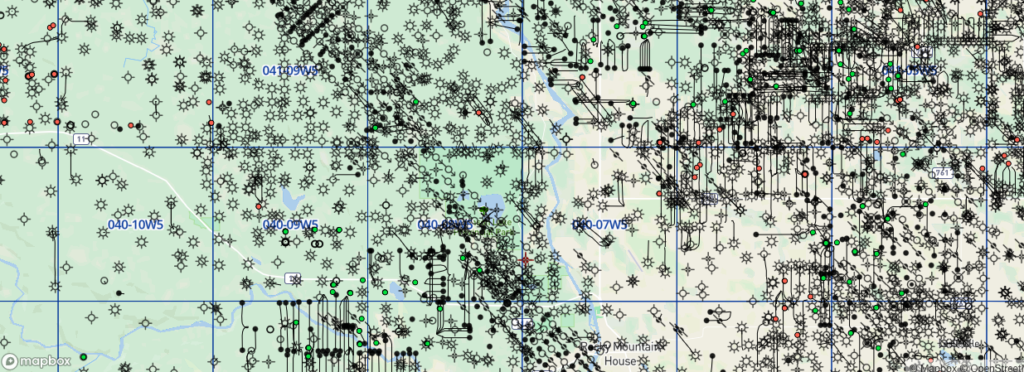Comment by a resident in Manitoba:
the pernicious mitigation myth again. I suppose these researchers must pretend everything can be mitigated just to keep their jobs.
New Type Of Earthquake ‘Triggered By Fracking’ Discovered by David Bressan, Dec 6, 2021, Forbes
According to a news release by the Ruhr-Universität-Bochum, a Canadian-German research team have documented a new type of earthquake in an injection field in British Columbia, Canada. Unlike conventional earthquakes of the same magnitude, they are slower and last longer. The events are a new type of induced earthquake that have been triggered by hydraulic fracturing (more popularly known as “fracking“), a method used in western Canada for oil and gas extraction.
With a network of eight seismic stations surrounding an injection well at distances of a few kilometers, researchers from the Geological Survey of Canada, Ruhr-Universität Bochum, and McGill University recorded seismic data of approximately 350 earthquakes. Their findings are published in the journal Nature Communications.
Around ten percent of the located earthquakes turned out to exhibit unique features suggesting that they rupture more slowly, similar to what has previously been observed mainly in volcanic areas, when molten rock is pushing upwards.
To date, researchers have explained the occurrence of earthquakes in the hydraulic-fracturing process with two processes.
The first says that the fluid pumped into the rock generates a pressure increase substantial enough to generate a new network of fractures in the subsurface rocks near the well. As a result, the pressure increase can be large enough to unclamp existing faults and trigger an earthquake, releasing energy accumulated due to tectonic stress.
According to the second process, the fluid pressure increase from injection in the subsurface also exerts elastic stress changes on the surrounding rocks that can be transmitted over longer distances. If the stress changes occur in rocks where faults exist, it can also lead to changes that cause the fault to slip and cause an earthquake.
Recently, numerical models and lab analyses have predicted a process on faults near injection wells that has been observed elsewhere on tectonic faults. The process, termed aseismic slip, starts out as slow slip that does not release any seismic energy. The slow slip can also cause a stress change on nearby faults that causes them slip rapidly and lead to an earthquake.
The lack of seismic energy from aseismic slip and the size of the faults involved make it difficult to observe in nature. Researchers have therefore not yet been able to document aseismic slip broadly with any association to induced earthquakes. The work of the current study, provides indirect evidence of aseismic loading, and a transition from aseismic to seismic slip.
The German-Canadian research team interpret the recently discovered slow earthquakes as an intermediate form of conventional earthquake and aseismic slip—and thus as indirect evidence that aseismic slip can also occur in the vicinity of wells. The researchers therefore dubbed the events hybrid-frequency waveform earthquakes (EHW).
“We’d assumed that induced earthquakes behave like most other earthquakes and have roughly the same rupture speed of two to three kilometers per second,” explains Rebecca Harrington. But that doesn’t always seem to be the case. While the shaking from a conventional earthquake of magnitude 1.5 (normally, earthquakes below magnitude 2 are not felt by people, but registered by seismic stations) in the researchers’ data set had died down after about seven seconds, an EHW earthquake of the same magnitude continued to shake for more than ten seconds.
The discovery could help to minimize damage done by tremors triggered by fracking. ![]() How? Frac’ers and their deregulators, AER, OGC, and the federal and provincial geological societies know the damages caused by frac’ing and frac quakes (newly named or old). They also know that frac’ers do what they want, and do not minimize or mitigate damages they cause, not even when they (eg Encana/Ovintiv) illegally, intentionally frac repeatedly into community drinking water aquifers. Mitigation costs too much money, and frac’ing loses too much money thus partners with debt and deception. To top the endless harms we must endure, frac’ers and their deregulators, lawyers and courts lie and further abuse the harmed.
How? Frac’ers and their deregulators, AER, OGC, and the federal and provincial geological societies know the damages caused by frac’ing and frac quakes (newly named or old). They also know that frac’ers do what they want, and do not minimize or mitigate damages they cause, not even when they (eg Encana/Ovintiv) illegally, intentionally frac repeatedly into community drinking water aquifers. Mitigation costs too much money, and frac’ing loses too much money thus partners with debt and deception. To top the endless harms we must endure, frac’ers and their deregulators, lawyers and courts lie and further abuse the harmed.
Frac’ers do not care about harms they cause to homes and farms, damages and risks to publicly paid for infrastructure like dams, bridges and roads, or how many they kill. They just care about conning workers, investors, the public and harmed to keep filling their pockets overflowing with taxpayer and investor subsidies, ego and evil. Frac’ers don’t even pay their taxes, don’t clean up, walk from responsibility, and get away with it in rape & pillage Canada. How and why the hell would any company or authority use these research results to reduce harm?![]()
“If we understand at which point the subsurface reacts to the hydraulic-fracturing process with movements that don’t result in an earthquake and, consequently, cause no damage to the surface, ideally we could use that information to adjust the injection procedure accordingly,” as Rebecca Harrington, head of the Hydrogeomechanics Group at Ruhr-Universität-Bochum, describes one implication of the study.
Fluid-injection-induced earthquakes characterized by hybrid-frequency waveforms manifest the transition from aseismic to seismic slip by Hongyu Yu, Rebecca M. Harrington, Honn Kao ![]() Read Dr. Kao’s incredibly nasty lie about induced quakes included below (in red), reported by Global News in 2016.
Read Dr. Kao’s incredibly nasty lie about induced quakes included below (in red), reported by Global News in 2016.![]() , Yajing Liu & Bei Wang, Nov 25, 2021, Nature Communications volume 12, Article number: 6862 (2021)
, Yajing Liu & Bei Wang, Nov 25, 2021, Nature Communications volume 12, Article number: 6862 (2021)
Abstract
Aseismic slip loading has recently been proposed as a complementary mechanism to induce moderate-sized earthquakes located within a few kilometers of the wellbore over the timescales of hydraulic stimulation. However, aseismic slip signals linked to injection-induced earthquakes remain largely undocumented to date. Here we report a new type of earthquake characterized by hybrid-frequency waveforms (EHWs). Distinguishing features from typical induced earthquakes include broader P and S-pulses and relatively lower-frequency coda content. Both features may be causally related to lower corner frequencies, implying longer source durations, thus, either slower rupture speeds, lower stress drop values, or a combination of both. The source characteristics of EHWs are identical to those of low-frequency earthquakes widely documented in plate boundary fault transition zones. The distribution of EHWs further suggests a possible role of aseismic slip in fault loading. EHWs could thus represent the manifestation of slow rupture transitioning from aseismic to seismic slip. …
However, induced earthquakes associated with hydraulic fracturing (HF) injection have recently challenged the conventional wisdom3 by successively generating larger and larger maximum magnitude earthquakes. For example, three M4.5+ HF earthquakes occurred since 2015 in the Western Canada Sedimentary Basin (WCSB)4,5,6,7, as well as the 2017 MW 4.7, 2018 ML 5.7, 2019 ML 4.9, and 2019 ML 5.3 earthquakes in the Sichuan Basin, China8,9,10. Studies suggest many M3+ events near HF wellbores are generated on seismogenic faults that are critically stressed, where injection facilitates rupture by shifting the stress state toward failure through pore pressure increase11,12 or poroelastic stress transfer10,13,14. However, geomechanical considerations often make it challenging to explain M3+ HF-induced earthquakes with the classical concepts of pore pressure and poroelastic stress change. For example, some observations show migration speeds of induced seismicity that outpace pore pressure diffusion15. Moreover, the relatively small volumes of total injected fluids are often likely insufficient or unable to generate significant poroelastic stress perturbations6,15. …
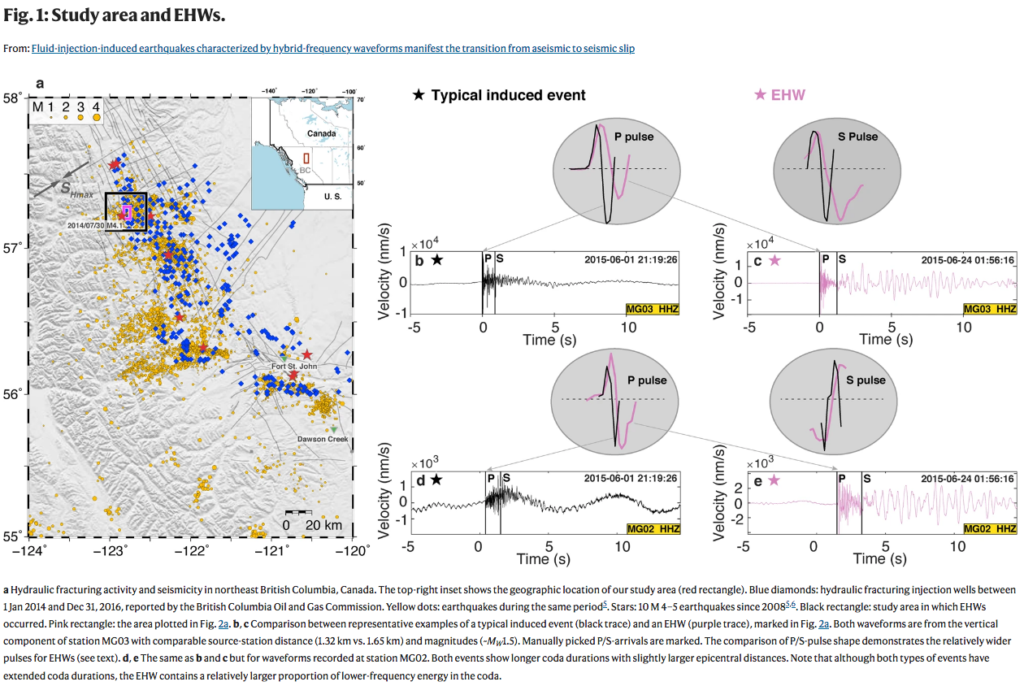
…
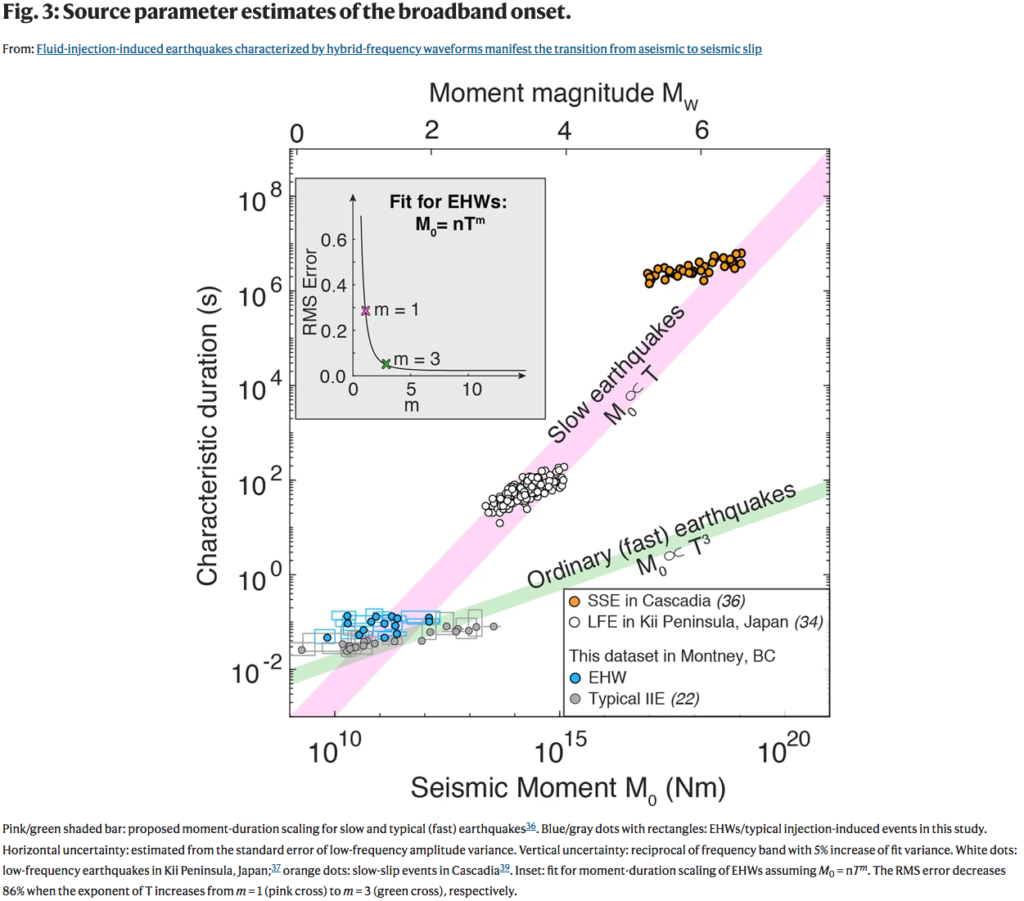
… Aseismic slip loading could be a viable mechanism to explain the early occurrence of EHWs at greater distances (Fig. 5d). …

Refer also to:
2000 04 01: Seismicity in the Oil Field
The gas field was discovered in 1956 and production began in 1962. Over the next 14 years, roughly 600×106 m3 of water, or 106 ton per km2, were injected. …
Beginning in 1976, a series of large earthquakes was recorded. The first significant earthquake occurred on April 8, 1976 at a distance of 20 km [12 miles] from the Gazli gasfield boundary.
The earthquake magnitude measured 6.8.
Just 39 days later, on May 17, 1976, another severe earthquake occurred 27 km [17 miles] to the west of the first one. The magnitude of the second earthquake was 7.3. Eight years later, on March 20, 1984, a third earthquake occurred 15 km [9miles] to the west of the second earthquake, with a magnitude of 7.2. … Aftershocks occurred in a volume surrounding the three hypocentres. These earthquakes are the strongest of all the known earthquakes in the plain of Central Asia. …
There was no clear relationship between the location of the earthquake hypocenters and any previously known active tectonic structures.
Closer investigation showed that the earthquakes had created new faults.
… In all these cases, the result of human interference was to change the state of stress in the surrounding volume of earth. If the stress change is big enough, it can cause an earthquake, either by fracturing the rock mass—in the case of mining or underground explosions—or by causing rock to slip along existing zones of weakness.
The situation in regions of hydrocarbon recovery is not always well understood: in some places, extraction of fluid induces seismicity; in others, injection induces seismicity.
… Even minor actions can trigger strong seismicity.
… The amassed data indicate that the Gazli earthquakes were triggered by the exploitation of the gas field. … In regions of high tectonic potential energy, hydrocarbon production can cause severe increases in seismic activity and trigger strong earthquakes, as in Gazli, Uzbekistan.
In regions of lower tectonic stress, earthquakes of that magnitude are less likely, but relatively weak earthquakes could occur and damage surface structures.
Between April 2009 and July 2011, in NEBC:
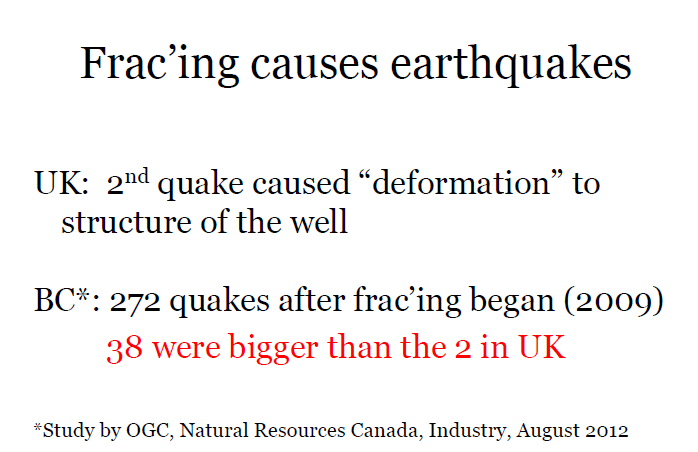
Slide from Ernst speaking events
2012: Investigation of Observed Seismicity in the Horn River Basin, NEBC:
Two instances of wellbore deformation along horizontal sections were reported by one operator.
2014:
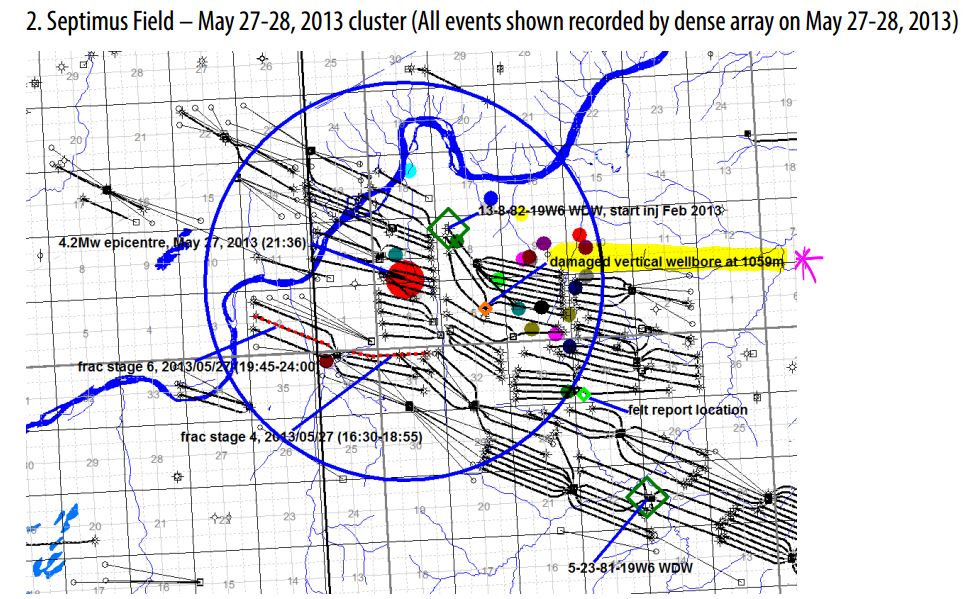
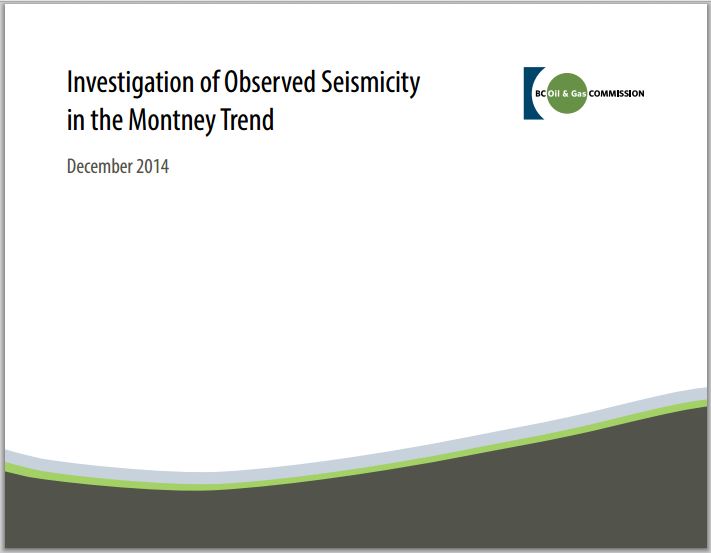
2015 09 18: Alberta frack operation near Devon shattered home window; No wonder Edmonton-area residents are protesting fracing near their homes
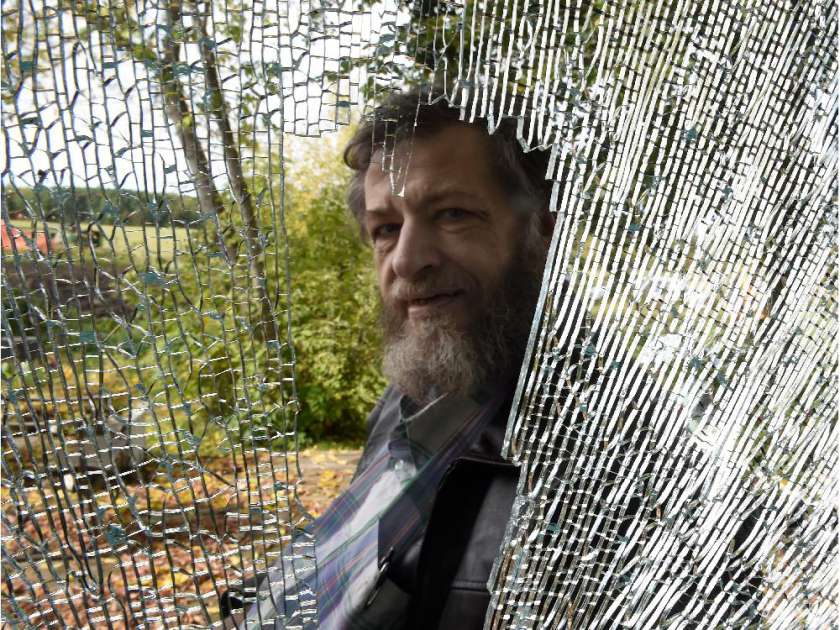
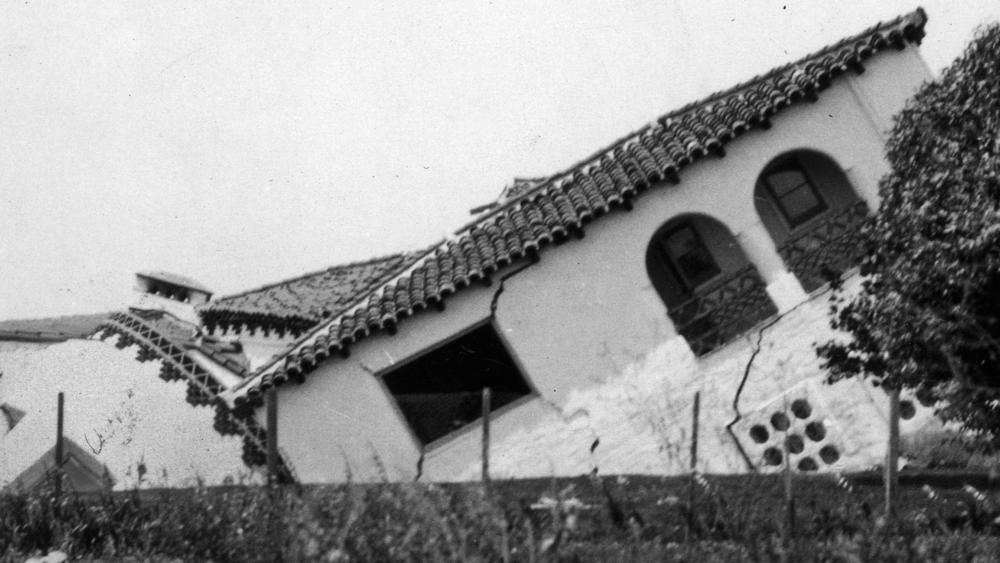
2016: USGS links Oklahoma’s 5.1M (third largest) earthquake to oil-field disposal wells more than 7 miles away [11.26 km]
2016: It’s Official: Kansas’ Biggest Earthquake, 4.9M in 2014, Caused by Frac Wastewater Injection
2016: 3.8M earthquake location changed from Yorkton to Esterhazy, Saskatchewan; Numerous injection wells there. Caused two hour power outage for several communities. Unbelievable quote by seismologist Dr. Honn Kao, Geological Survey of Canada: “Man-made activity will not cause this kind of magnitude event unless it’s nuclear explosion” (As of today, Dec 6, 2021, Global News has not reported a correction or retraction.)

Esterhazy was hit with a bigger quake in 2019, post included below.
Quake Damages Photo B: Patio stones are lifting (similar damages experienced by Ann Craft from frac’ing by Quicksilver near Ponoka):
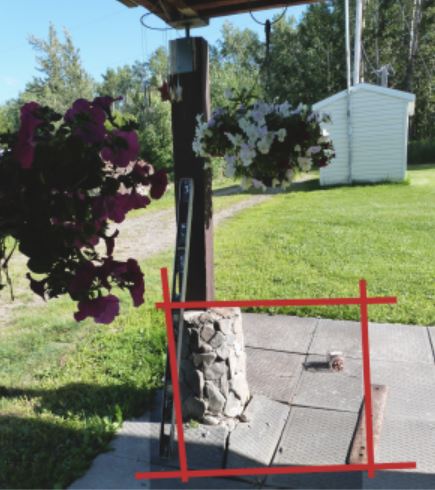
Quake C Photo: Siding on the house is buckling:
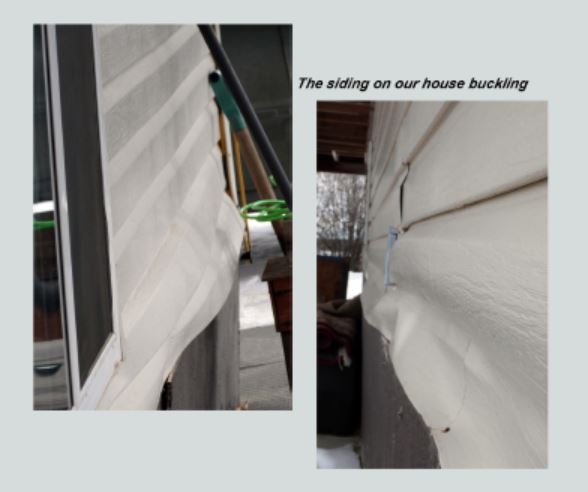
Quake D Photo: Interior home walls cracked and door ruined. No point repairing anything because the quakes keep undoing the repairs:

More damning photos at link.
2021 04 22: Frac’d to Hell NEBC, Kiskatinaw area: After fracs were stopped, quakes keep shaking
… Now, a comprehensive new scientific study warns that stress changes caused by the technology could trigger a magnitude 5 earthquake or greater in the region, resulting in significant damage to dams, bridges, pipelines and cities if major regulatory and policy reforms aren’t made soon.
Allan Chapman, the author of the paper served as a senior geoscientist for B.C.’s Oil and Gas Commission and as its first hydrologist from 2010 to 2017. Prior to working for the commission, he directed the Ministry of Environment’s River Forecast Centre, which forecast floods and droughts.
Chapman, now an independent geoscientist, said that he felt compelled to write the paper because researchers have concluded that fracking “induced earthquakes don’t have an upper limit” in terms of magnitude.
In addition, “there is a clear and present public safety and infrastructure risk that remains unaddressed by the regulator and the B.C. government.” …
2021 06 06: Japex sells Canadian shale gas “asset” to frac quaker Petronas for “extraordinary loss of C$493 million”
2021 06 14: When will the frac’ing insanity stop? Worrying Rystad Energy frac quake analysis.
One of the many “felt” reports:
“At the coordinates you give for the epicentre there is a big frack going on….”

Some of industry’s wells in the quake area, from BOE Report:
